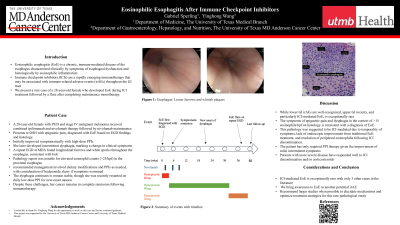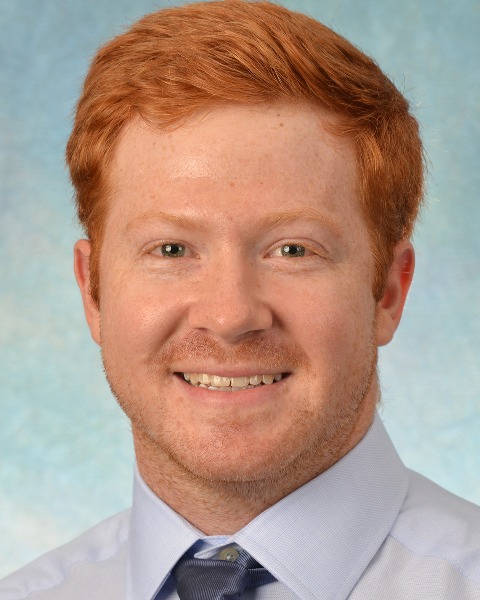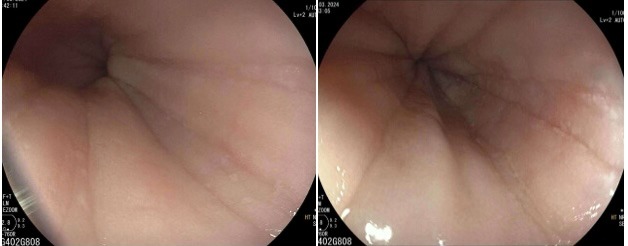Tuesday Poster Session
Category: Esophagus
P4000 - Eosinophilic Esophagitis in a Patient Who Received Immune Checkpoint Inhibitors
Tuesday, October 29, 2024
10:30 AM - 4:00 PM ET
Location: Exhibit Hall E

Has Audio

Gabriel Sperling, MD
University of North Carolina Hospitals
Chapel Hill, NC
Presenting Author(s)
Gabriel Sperling, MD1, Yinghong Wang, MD, PhD2
1University of North Carolina Hospitals, Chapel Hill, NC; 2University of Texas MD Anderson Cancer Center, Houston, TX
Introduction: Eosinophilic esophagitis (EoE) is a chronic, immune-mediated disease of the esophagus characterized clinically by symptoms of esophageal dysfunction and histologically by eosinophilic inflammation. Immune checkpoint inhibitors (ICIs) are a rapidly emerging immunotherapy that may be associated with immune-related adverse events (irAEs) throughout the GI tract. We present a rare case of a 28-year-old female who developed EoE during ICI treatment followed by a flare after completing maintenance monotherapy.
Case Description/Methods: A 28-year-old female with stage IV malignant melanoma treated with nivolumab/ipilimumab dual therapy now on nivolumab maintenance monotherapy presented to the ED for acute, worsening epigastric pain. EGD findings were notable for a duodenal ulcer, while esophageal biopsy results showed 20 eosinophils/hpf. She initially improved symptomatically with high-dose PPIs, but later developed new-onset dysphagia despite being off nivolumab maintenance for 3 months. A repeat EGD found longitudinal furrows and white specks throughout the esophagus, more prominent from the EGD 8 months earlier, and a healing duodenal ulcer. Biopsy results again noted elevated eosinophil counts ( >25/hpf) in the proximal esophagus. Given her mild, intermittent disease, conservative management with dietary modifications and PPIs as needed was recommended with consideration of budesonide slurry if symptoms worsened. The dysphagia remains stable, though she was recently restarted on daily low-dose PPI for new-onset nausea. Despite these challenges, her cancer remains in complete remission following immunotherapy.
Discussion: While lower GI irAEs are well-recognized, upper GI irAEs, and particularly ICI-associated EoE, is exceptionally rare with only 3 other cases in the literature. Symptoms of abdominal pain and dysphagia with >15 eosinophils/hpf on histology is consistent with a diagnosis of EoE. This pathology was suggested to be ICI-mediated due to temporality of symptoms, lack of endoscopic improvement from traditional EoE treatment, and resolution of peripheral eosinophilia following ICI discontinuation. This patient has only required conservative non-immunosuppressive therapy given her symptomatic improvement and mild disease. However, patients with severe disease have responded well to ICI discontinuation and/or corticosteroids. We bring awareness to EoE as another potential irAE and recommend larger studies to elucidate mechanisms and optimize treatment strategies for this rare pathology.

Disclosures:
Gabriel Sperling, MD1, Yinghong Wang, MD, PhD2. P4000 - Eosinophilic Esophagitis in a Patient Who Received Immune Checkpoint Inhibitors, ACG 2024 Annual Scientific Meeting Abstracts. Philadelphia, PA: American College of Gastroenterology.
1University of North Carolina Hospitals, Chapel Hill, NC; 2University of Texas MD Anderson Cancer Center, Houston, TX
Introduction: Eosinophilic esophagitis (EoE) is a chronic, immune-mediated disease of the esophagus characterized clinically by symptoms of esophageal dysfunction and histologically by eosinophilic inflammation. Immune checkpoint inhibitors (ICIs) are a rapidly emerging immunotherapy that may be associated with immune-related adverse events (irAEs) throughout the GI tract. We present a rare case of a 28-year-old female who developed EoE during ICI treatment followed by a flare after completing maintenance monotherapy.
Case Description/Methods: A 28-year-old female with stage IV malignant melanoma treated with nivolumab/ipilimumab dual therapy now on nivolumab maintenance monotherapy presented to the ED for acute, worsening epigastric pain. EGD findings were notable for a duodenal ulcer, while esophageal biopsy results showed 20 eosinophils/hpf. She initially improved symptomatically with high-dose PPIs, but later developed new-onset dysphagia despite being off nivolumab maintenance for 3 months. A repeat EGD found longitudinal furrows and white specks throughout the esophagus, more prominent from the EGD 8 months earlier, and a healing duodenal ulcer. Biopsy results again noted elevated eosinophil counts ( >25/hpf) in the proximal esophagus. Given her mild, intermittent disease, conservative management with dietary modifications and PPIs as needed was recommended with consideration of budesonide slurry if symptoms worsened. The dysphagia remains stable, though she was recently restarted on daily low-dose PPI for new-onset nausea. Despite these challenges, her cancer remains in complete remission following immunotherapy.
Discussion: While lower GI irAEs are well-recognized, upper GI irAEs, and particularly ICI-associated EoE, is exceptionally rare with only 3 other cases in the literature. Symptoms of abdominal pain and dysphagia with >15 eosinophils/hpf on histology is consistent with a diagnosis of EoE. This pathology was suggested to be ICI-mediated due to temporality of symptoms, lack of endoscopic improvement from traditional EoE treatment, and resolution of peripheral eosinophilia following ICI discontinuation. This patient has only required conservative non-immunosuppressive therapy given her symptomatic improvement and mild disease. However, patients with severe disease have responded well to ICI discontinuation and/or corticosteroids. We bring awareness to EoE as another potential irAE and recommend larger studies to elucidate mechanisms and optimize treatment strategies for this rare pathology.

Figure: Endoscopic images showing esophagus with linear furrows and whitish plaques
Disclosures:
Gabriel Sperling indicated no relevant financial relationships.
Yinghong Wang: AzurRx – Consultant. Ilyapharma – Consultant. IOTA – Consultant. Sorriso – Consultant. Tillotts – Consultant.
Gabriel Sperling, MD1, Yinghong Wang, MD, PhD2. P4000 - Eosinophilic Esophagitis in a Patient Who Received Immune Checkpoint Inhibitors, ACG 2024 Annual Scientific Meeting Abstracts. Philadelphia, PA: American College of Gastroenterology.
